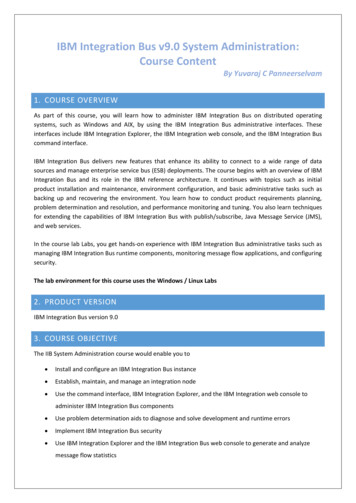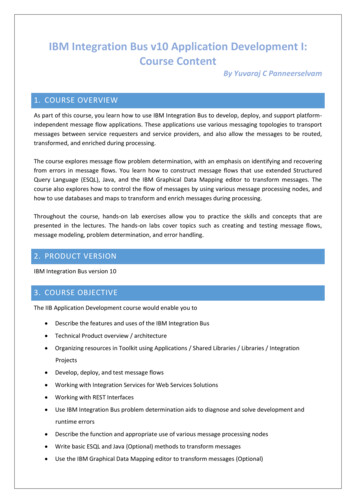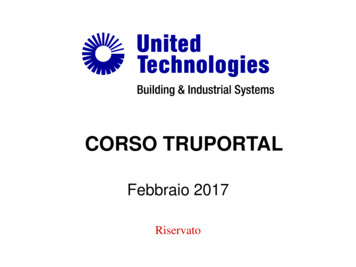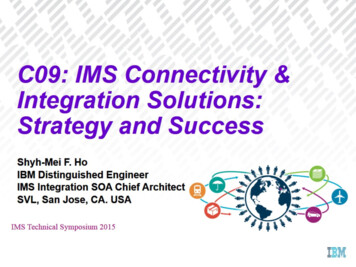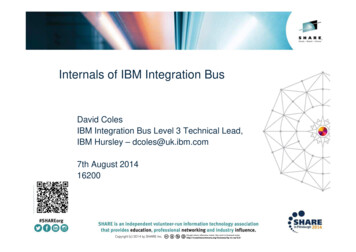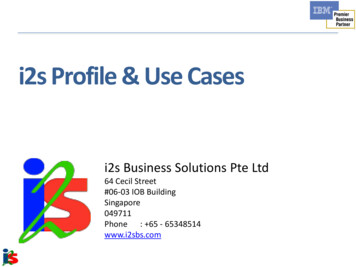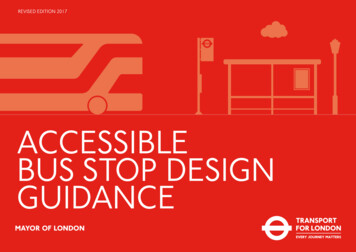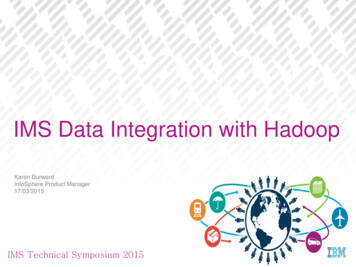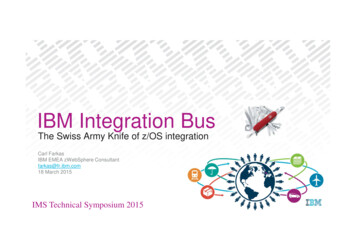
Transcription
IBM Integration BusThe Swiss Army Knife of z/OS integrationCarl FarkasIBM EMEA zWebSphere Consultantfarkas@fr.ibm.com18 March 2015IMS Technical Symposium 2015*
System z Technical University THE IBM z System conference in Europe for 2015 As well as the new z13, z/OS, etc., loads of sessions on IMS and other zSystem topics: MQ z/OS, DB2, CICS, WAS z/OS, IIB z/OS . Dublin, 18-22 May 2015 n?pageType page&c Q549350A81365Q21 Meet the developers and meet your peers throughout Europe A terrific investment in your skills22
Agenda What’s an ESB? What is the IBM Integration Bus?– Development– Administration– Architecture IIB on z/OS– IIB and IMS– Who is using an IIB?3
What is an “Enterprise Service Bus (ESB)”?"Gartner estimates that up to 30% of the cost of implementing an application is related to thedevelopment of the interfaces” -GartnerApplication BApplication ACICSESBAdapterAdapterTransportTransport The “Broker” (or “hub” or “gateway” or ) is central and the intermediary between the applications It typically has responsibility for routing and transforming data between the applications An ESB must be polyvalent with support for multiple data formats and protocols, extremely reliable and scalable4
Business value of an ESB Traditional communications Point to point Each application must adapt thedata to its particular need The number of transformationsgrows exponentially n*(n-1) Communications with a ESB Hub ‘n spoke logic Maintenance can be centralised Promotes reutilisation(Note: although an ESB appears architecturallyas a single middle point, scalability and highavailability requirements imply that multiplephysical hubs are required)5ESB
Agenda What’s an ESB? What is the IBM Integration Bus?– Development– Administration– Architecture IIB on z/OS– IIB and IMS– Who is using an IIB?6
What is the IBM Integration Bus? IBM’s strategic enterprise integration technology Single engineered product for fully heterogeneous integration scenariosIBM Integration BusERP/EIS/CRMFilesWeb 2.0 DevicesWeb ServicesRetailMicrosoftMQ, abasesMobileIBM Integration Bus is the new name for WebSphere Message Broker 7Technology progression over 15 years, installed at 2500 customers worldwide across all industriesFully supported worldwide by IBM global support network, standard 5 3 years support policyVersion to version migration is key design considerationGlobal skills availability - SME’s available globally via IBM and partnersClose interaction with growing and loyal customer base: beta and lab advocacy programs
IBM Integration Bus . Routes, Transforms, Augments “messages” Accepts a large variety of “messages”: MQ, JMS, HTTP, SOAP, TCP/IP, local files, FTP, etc.) Supports multi-format (XML, SOAP, fixed, variable length, tagged, SWIFT, IDOC, etc.) Offers full database support (DB2, Oracle, Informix, Microsoft SQL Server, Sybase, etc.) Supports common ERP and EIS interfaces (CICS, IMS, SAP, PeopleSoft, Siebel, etc.) Provides a drag ‘n drop visual development based upon Eclipse, supporting a variety of development languages (Java, eSQL, XSLT, PHP, .Net, etc.)Offers a scalable, high-performance, resilient, low-latency “execution container”Supports transactionality (2-Phase-Commit)Supports Point-To-Point, Pub/Sub, Event, Synchronous and Asynchronous messageprocessing stylesIncludes full life-cycle tooling (development, administration, runtime)Is extensible with open parser, node & administration interfacesSupports all major hardware and O/S platformsTruly the “Swiss Army knife” of integration!88
IBM Integration Bus HistoryIBM Integration Bus V10March 2015IBM Integration Bus V9.0June 20011WebSphere Message Broker V8.0Oct 2011W itor.Performance tests (see MP16 andMP1J support packs). show 1000 tx/sec. Can causesignificant IMS logging.No problem reportedIMS 13 perf: 100K tr/sec!!No figures available, but likely lessperformance than alternativespresented here.Scalability & HAWith MQ SQs for HA & scalability.With MQ SQs for HA & scalability.With multiple port per ICONWith multiple ICON & SysplexDistributor.With multiple port per ICONWith multiple ICON & SysplexDistributor.39
Agenda What’s an ESB? What is the IBM Integration Bus?– Development– Administration– Architecture IIB on z/OS– IIB and IMS– Who is using an IIB?40
A few IIB customers that presented their stories atInterConnect2015 Perhaps you’ll be the next?Aer LingusDid you know that many of the largest financial institutions inGermany, France, UK, France, Italy, Spain, USA, etc. are usingthe IIB (WMB) on z/OS today?41
“A large financial company in Australia” One of the largest financial companies in Asia-Pacific is using the Broker formany years on z/OS. Broker used for many different applications, and notably as a commonintegration interface for Internet and Mobile banking. Steady prime-time sustained Broker transaction rates exceed 1.1 milliontrans/hour ( 300 trans/second), with higher peaks spread over 2 x LPARs. Upstream queries are going to IMS, over MQ adapter.42
Swedbank One of the largest banks in Sweden, and runningthe WMB for many years. Swedbank used to run WMB on Distributedplatforms, but migrated to z/OS in 2009. Thepreferred z/OS for its QOS (HA, scalability,stability, backup, management, etc.). Over 150 flows are in production today, and moreare on the way. Most requests are arriving to WMB via MQ or SOAP/HTTP, and then Interfacing toIMS “upstream”. The WMB is seen more and more as the primary “service provider”. Most new development is exploiting Java on z/OS; exploiting the speed and economyof Java on the mainframe. Swedbank is leveraging MQ Shared Queues.43
DNB Norway’s largest financial services group, and running WMB for many yearson z/OS for multiple projects. Broker flows accept multi-channel requests (ATMs,Net banks, mobile, etc.), manyvia raw TCP nodes. Peaks of 200 MQ msgs/second,using MQ-IMS Bridge. IMS outbound flows also via MQ Adapter. Broker also used for high-value payments platform and SWIFT interfacing.44
Summary Universal Enterprise Service Bus– The IBM Integration Bus supports a wide range of different data formats, protocolsand transformation “languages” Simple & Productive– IIB provides a complete interface for defining, modifying and routing data Dynamic, Managed & Secure– IIB allows the creation of dynamic and governed solutions High Performing & Scalable– IIB provides a platform and technology neutral connectivity option IMS-ready– Running today with rich, effective IMS interfacing4545
And how about IIB v10? Flexible MQ topologies– Much more flexibility in IBM MQ usage– The IIB in many cases can now directly use 0-N queue managers; MQ is nolonger a pre-requisite for IIB (note: for the moment, however, still required onz/OS) Big emphasis on simplifying development, attracting development community– Significantly smaller footprint (1GB)– Very fast install (a few minutes)– Richer unit test environment, regression testing– Externalized policies for runtime properties– Real shared libraries– New generators for JavaScript and REST interfacing46IIB v10announcedand GA 13March 2015!
Backup47
Bibliography GI13-3314 Program Directory for IBM Integration Bus for z/OS IBM Integration Bus home page - tion-bus SG24-7090 WebSphere Business Integration Message Broker Basics SG24-7006 Implementing and Administering WebSphere Business Integration Server SG24-6088 WebSphere Business Integration Pub/Sub Solutions REDP3894 Implementing High Availability for WBI Message Broker on z/OS SG24-7283 Managing IIB Resources in a Production Environment SG24-7826 Connecting Your Business Using IBM WebSphere Message Broker V7 as an ESB WP101617 Migration to WebSphere MQ V7.0.1 and WebSphere Message Broker V7.0 on z/OS REDP4458 Using the New Features in WebSphere Message Broker V6.1 SG24-7335 Implementing an ESB using IIBv6 and WESBv6 on z/OS REDP4644 WebSphere Message Broker V7.0 Integration with WebSphere Adapter for SAPThe full IIB documentation is available online MKHH 9.0.0/mapfiles/help home msgbroker.html48
QSAM nodesS Y S 1 .R E A D M ECARLM IK IK IM FileAdapter Filename SYS1.README Action OPEN /Action : /Filename /FileAdapter CLOSEKIMMIKICARLOPEN Nodes work with sequential QSAM datasets (flat or PDS(E)): FileRead, FileWrite, FileDelete, FileRename SupportPac IA11, level 3 (product extension), only available on IIB for z/OS Simple, straight-forward interface passing name of file and control information via input message to the node FileRead: the lines of the dataset are returned, 1 message per line FileWrite: the node writes a a record to the VSAM dataset for each message received Not an “input” node; the QSAM nodes are called synchronously within the flow49
VSAM nodes Suite of 5 nodes to perform operations on VSAM Files VSAM Input Node VSAM Read Node VSAM Write node VSAM Update node VSAM Delete node VSAM file support: KSDS, ESDS, RRDS, KSDS PATH, ESDS PATH SupportPac IA13, level 3 (product extension), only available on IIB for z/OS Set parameters in node properties, or via control messageBlah, blah, blahOutStatus50Blah, blah, blah
CICS node Synchronous call within a flow to a CICS transaction Simple interface with parameters pre-set on node or via input message COMMAREA and Channel support Works in 2-tier (IIB - CICS) or 3-tier (IIB- CTG- CICS)51
IMS Node IMS Request node– Allows message flows to call IMS transactions and handle responses– Typical scenarios include Web Service- IMS, File- IMS, SAP- IMS – Provides high performance, synchronous, multi-platform access to IMS– Complements MQ IMS Bridge and IMS Web Services currently accessible via Broker Synchronous invocation of IMS transactions and commands– Supports a broad range of IMS facilities MPP, BMP and Fast Path transaction regions Commit mode 0, 1 SyncLevel NONE, CONFIRM Single and multi segment IMS messages Exploits IMS TM Resource Adapter– Delivered built into IIB, no extra cost/install/customization required IMS Connect is required, but free of charge with IMS– Configurable Services allow operational control of IMS connection configuration5252
v9: Decision Management (ODM) support Provide business insight during integration data flows e.g. intelligent decision making; score then action in-flight request based on abusiness rule User creates (e.g.) if-then-else rules using tool of choice (Excel, Word, Eclipse ) The bus acts on these rules in flow, e.g. for business level routing New Decision Service node Identifies inputs to business rules from in-flight data e.g. the customers order from whole request e.g. the item price from key fields Invokes the built-in rule engine to perform business logic Create rules directly inside Integration Bus toolkit Automatic package & deploy with integration assets Dynamically reconfigure business rule using configurable service policy Optionally refer to business rules on external ODM decision server Exploit separate full ODM Decision Center for BRMS scenarios Embedded rules engine for high performance Rule is executed in the same OS process as integration data flow Rule update notification ensures consistent rule execution Optional governance of rules through remote ODM Decision Center53
v9: IBM Integration Bus modesIntegration Bus for z/OSStandardCapabilityStandardformode/ VU)z/OS( xxxSp.PLAY(12 VUs at list)Advanced forz/OS( yyy / VU)StandardScale mode( xxx / VU)54
v10: Flexible MQ Topologies Provide more flexible topology options for MQ access– Many benefits include simplicity, scalability, availability & migration– Relationship evolves to the same as other resource managers – i.e. optional– Multiple Buses connected to a single Queue Manager– Corresponding updates for commands, CMP & Admin tools Automated installation simplified– MQ resources will not be installed at the same time– Reduces dependency management– Simplifies cloud-based installs– If MQ is installed, then IIB will detect this and configure appropriately IB now supports Local and Remote queue managers– Allows IB to be remote from its queue manager– Works with single MQ IB support to further simplify MQ topology– Many other internal features within IB can exploit this flexibilityIB1IB2QMIB3IB1IB2QMThis image cannot currently be displayed. Many MQ Node related Enhancements– Input node supports multiple input queues, both local & remote queue managers Includes easy-change policy based control of sources Also applies to MQGet and MQOutput/MQReply nodes– Many other MQ node enhancements in pipeline: PubSub, Request/Reply When a queue manager is not available – Some features require MQ e.g. aggregation nodes, XA coordination, SAP Nodes55 collector nodes, etc.IB3LocalorRemoterequest
v10: Unit Test and Regression Test Improved Facilities for Unit Test and Regression Test– Simple to understand, fix and re-factor behaviour duringdevelopmentTest suiteTotalPassFailPercentMy flows2015575Your flows5048296 Valuable, foundational first use cases– Observe data passing through a flow– Capture these data in “test case”– Build regression suite from test cases– Save data to test case– .ibtest contents to define input (source) request and expectedoutput (target) response. Collected into unit test library forsubsequent execution Regression Testing– C
What is the IBM Integration Bus? IBM's strategic enterprise integration technology Single engineered product for fully heterogeneous integration scenarios IBM Integration Bus is the new name for WebSphere Message Broker Technology progression over 15 years, installed at 2500 customers worldwide across all industries
